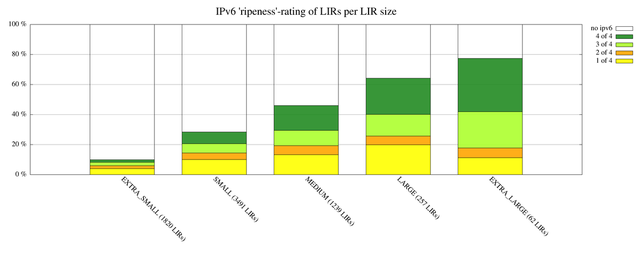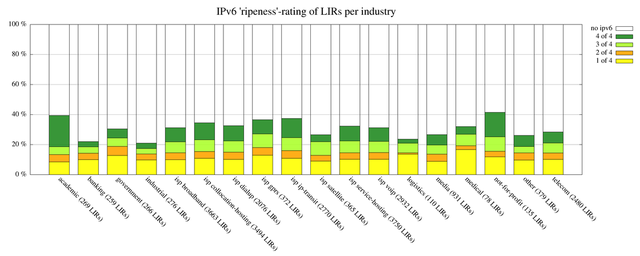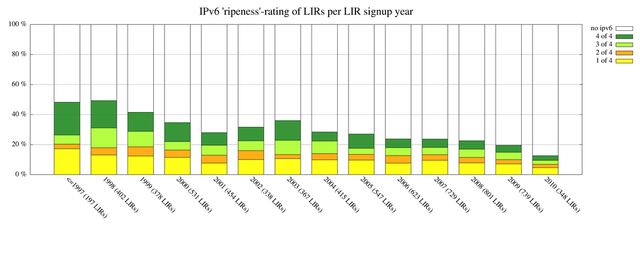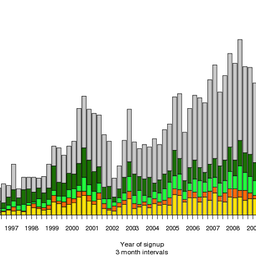As a follow-up to the article IPv6 RIPEness of LIRs, we did more analysis based on LIR signup year, size and the industry sector that the LIR operates in.
This article contains more analysis of the IPv6 Ripeness of LIRs , based on LIR signup year, size and the industry sector that the LIR operates in. We see that older LIRs and larger LIRs are more IPv6-ripe, and a number of industries are lagging behind, specifically banking, industrial and logistics.
In the previous article on IPv6 RIPEness we showed the first results of a simple system of rating the IPv6 readiness of LIRs. We rated LIRs based on four criteria that we routinely collect data on:
- The LIR has an IPv6 allocation.
- The prefix is routed.
- There is a related route6 object in the RIPE Database.
- Reverse DNS has been set up.
The graphs below (Figure 1 to 3) show the same ratings, but now aggregated based on:
- The size of the LIR according to the billing category
- The age of the LIR, i.e. when the organisation signed up to become an LIR with the RIPE NCC; and
- The industry sector the LIR operates in.
The size of an LIR size is calculated by the RIPE NCC on a yearly basis. The industry sector is determined by an organisation when it registers as an LIR with the RIPE NCC. Please note, that an LIR can decide to be in more than one industry sector.

Figure 1: IPv6 RIPEness grouped by billing category
In Figure 1 we see that the larger the LIR, the more IPv6-ripe it is. This indicates that large LIRs have IPv6 on their radar and have taken steps to deploy IPv6, which is encouraging to see.

Figure 2: IPv6 RIPEness grouped by industry
In Figure 2 we see IPv6 RIPEness sorted by industry sector, as set by the LIRs themselves. Academic and non-for-profit are the most positive cases here, but it is a little surprising that they don't score higher. The lowest scoring industries are banking, industrial and logistics. An explanation for that could be that IPv6 is not part of their core business. On the other hand, it is odd that a relatively large fraction of businesses in these competitive industries don't seem to pay attention to IPv6 yet, where lack of planning for IPv6 deployment could be seen as a business continuity risk. It is also interesting to note that government-related LIRs score around the average. This could indicate that there is still an opportunity for governments to lead the way on IPv6 adoption.

Figure 3: IPv6 RIPEness grouped by year of becoming an LIR
In Figure 3 we see IPv6 RIPEness according to the year the LIR signed up with the RIPE NCC. The general trend here is that the older the LIR, the more IPv6-ripe it is. Some potential explanations for this:
- Older LIRs have had more time to act.
- There is more focus on business continuity in older LIRs.
- There is a correlation between age and size causing this.
If you have other likely explanations, please post them under the article.
We also see a dip around 2001 or a small peak around 2003 - depending on how you look at it. The most likely explanation for this is the dot-com bubble .
We conclude that older and larger LIRs score better on the IPv6-ripeness rating system, as do academic and non-for-profit LIRs. If there are other groupings of LIRs that you think are interesting to compare, please let us know. You can leave comments or send email to the RIPE Labs mailbox .
Note that all measurements were done on 3 June 2010.










Comments 0
The comments section is closed for articles published more than a year ago. If you'd like to inform us of any issues, please contact us.